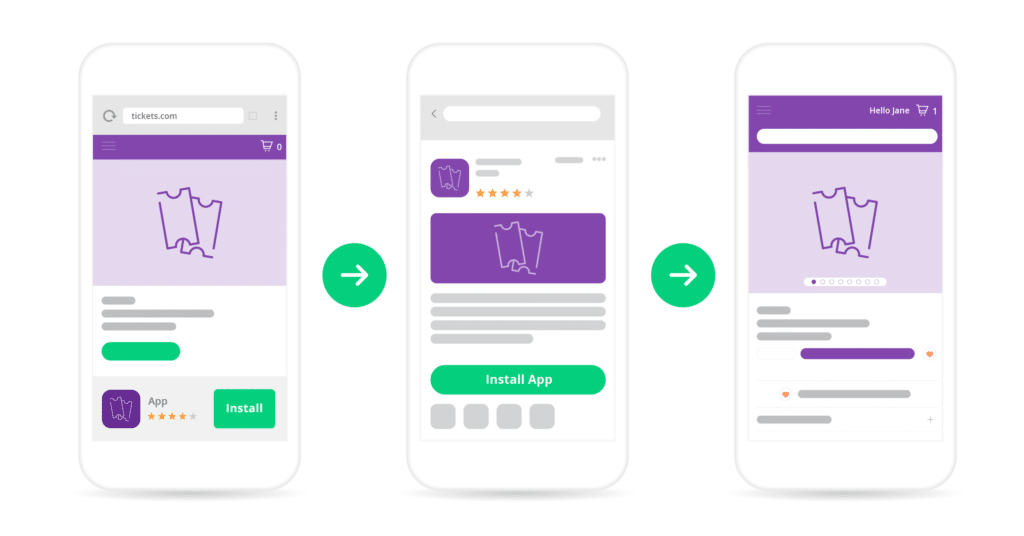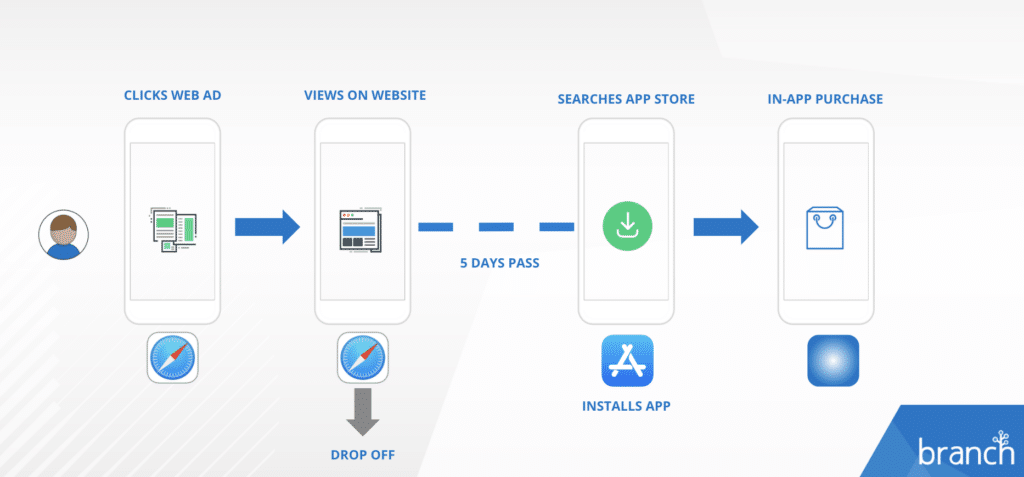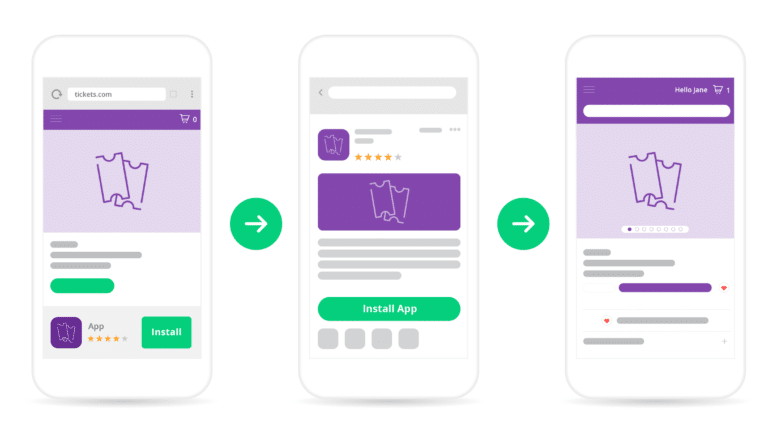Tracking app store downloads from the mobile web might seem like a simple challenge for mobile marketers. But with ever-more channels involved in user journeys, going beyond last-click attribution to determine which channel or campaign really deserves credit for that install can be deceptively complex.
Let’s take a look at a real-life example from GrowthHackers (we’re a little biased because this customer chose Branch to solve their challenge): A mobile marketer was running a Google AdWords campaign to drive traffic to a webpage that linked users to the app store and the opportunity to download their app.
How could this marketer track those downloads and effectively attribute them back to the Google AdWords campaign?
While this example was specific to Google AdWords, it could have focused on almost any other paid or organic marketing campaign.
So how can you accurately attribute installs from your paid and organic campaigns on the mobile web?
Before we dive into the specifics, let’s define mobile app install tracking – and why it’s so important.
What Is Mobile App Install Tracking?
Mobile app install tracking ensures the number of people who install an app are accurately attributed to the channel or campaign that influenced their install
But due to complex user journeys across multiple devices and channels, and disparate reporting between app stores, it can be really difficult to achieve a clear view of which campaign truly influenced those installs.
In fact, misattribution of installs not only leads to skewed marketing spend based on a misunderstanding of which channels and campaigns are truly performing, but it also reduces the amount of credit mobile and app marketers should receive for their efforts.
Marketers and product managers alike need a way to track both organic and paid performance from the mobile web to the app store, then into the app. Here’s how the ideal user journey should look:

Why Is Attributing Beyond App Stores So Important?
In 2018, the Apple App Store and Google Play Store reported a combined 105.8 billion app downloads.
With the volume of app downloads continuing to increase YOY, marketers and product managers have to figure out a way to accurately attribute those installs beyond the install event alone.
As users have multiple opportunities to interact with brands across social media, emails, paid ads, and marketing campaigns, the inability to measure mobile marketing efforts at scale can mean inaccurate and disorganized quarterly reporting — and annual reports that don’t show the full impact of every channel on installs and revenue.
Attributing App Installs From the Mobile Web
The average person spends more than four hours on their phone per day, according to Inc.com. Google’s research also shows that, when in need, 87% of users still turn to a web search engine first.
So odds are, when a user searches for your brand or solution, they’ll be finding you on mobile – and there’s a high chance they’ll land on your mobile website.
Key example: Let’s say a user is searching for a pair of rain boots. After a search on Google, the user lands on an ecommerce mobile website that has the exact boots she’s been searching for. But the mobile website takes a while to load, and when she tries to check out, the clunky experience of entering her payment information leads her to bounce instead of buy.
Mobile websites simply can’t offer the same seamless experience as native apps, where users are proven to spend up to 3x more according to Criteo’s research.
But connecting the dots from the mobile web to app install and conversion requires a sophisticated technology that can match user behaviors from the mobile web into the app and accurately attribute that performance.
Let’s take a look at one way this experience could have been improved and attributed.
Leveraging deep linking and Branch’s Journeys, the ecommerce provider could have served that user with a floating mobile web banner promoting boots on sale with a prompt to install the app.
Deep linking the user seamlessly from the mobile website into the appropriate app store and then directly to the pair of boots the user was interested in would have not only initiated an install, but also made it more likely the user would complete a purchase.
Even better? Since deep linking is a thread that carries this user from mobile web into the app, Branch’s Journeys can also report more accurately on the actual source of her conversion: Organic Search.
Now, let’s take a look at how to track app store installs from mobile paid ads.
Attributing from Mobile Paid Ads to Install
Another path users travel from the mobile web to installing your app: Paid ads.
While paid acquisition can lead to a high volume of installs, it’s important to be able to prove your investment in paid ads led directly to that performance. Similar to the mobile web use case, ensuring your attribution can go beyond the app store and last-click attribution is the only way to make sure your paid ads are driving installs.
That’s where deep linking and Branch’s Universal Ads comes in.
Using Universal Ads, you can drive your users seamlessly into the right app store, and after download, deliver them to the offer they clicked on so they can check out seamlessly. In the best case scenario, though, you’re able to make that match even if days pass between the click and the ultimate conversion. Let’s take a look at how that ideal flow works:

Branch’s deep links work with virtually any ad network, with pre-configured integrations that make it easier than ever to deploy Universal Ads for your paid campaigns so you can accurately attribute performance in any app store.
The Biggest Challenge: Fingerprinting
We’ve discussed two ways to track app store downloads from the mobile web, but there’s a key consideration we haven’t addressed yet – and that’s matching a user from the mobile web to an app install.
Arguably, this is the biggest hurdle any marketer or product manager faces. While a number of attribution providers are able to track basic app install campaigns, when complex user flows like those above are involved, it becomes more difficult to achieve match rates you can rely on.
Legacy attribution providers often rely on fingerprinting to match users from the mobile web to an app store install, but this method leads to discrepancies and misattributions.
Before we dive into how to improve the accuracy of attribution, let’s look at fingerprinting – and why it needed to be improved. Fingerprinting works by tracking as much information about the browser upon the click before redirecting to the appropriate app. At a high level, fingerprinting stores unique user properties (such as IP address, user agent, etc.) on a server.
Then, when a user installs the app, those properties are compared to properties read directly from the native app. Compare these properties with those from the initial click, and if there’s a match, you’ll know with 60-70% certainty that it’s the same user from click to install.
But fingerprinting is highly reliant upon the users’ IP address, so it breaks on large public or corporate networks, where many users may be clicking and installing at the same time. It will also break in the scenario where the user connects or disconnects from wifi, changing the IP.
Branch’s Attribution Solves the Challenge of Accurate Install Tracking
After years of being in development and testing, Branch introduced a completely new way of measuring attribution that nearly eliminates the need for fingerprinting: Attribution. It uses the wisdom of the crowds to build a large identity graph of cookies mapped to device IDs, generated from the tremendous amount of traffic Branch sees. For pure app attribution, it solves that use case easily. Then, if you have more complex user flows, involving mobile web or other platforms, the attribution system can track those as well.
Both Journeys and Universal Ads are built upon this identity graph, which can deliver much more accurate matching and attribution than fingerprinting.
Here’s proof: We did a simulated comparison of Branch’s method to a fingerprint method. The result: Nextdoor reduced misattributions by 25% thanks to Attribution. That means that a majority of fingerprint misses were resolved.
Ready to reduce your misattributions and unlock the full-funnel view of your installs from paid and organic marketing efforts? Contact our sales team today to find out how you can go beyond fingerprinting to track app store downloads from the mobile web.






















